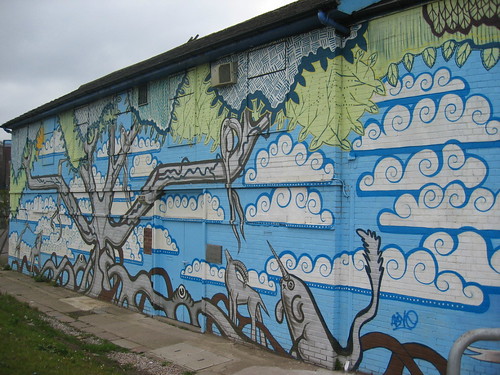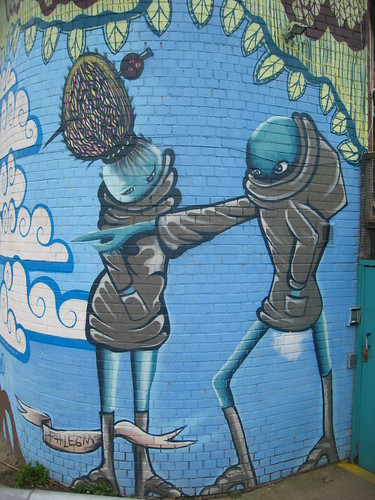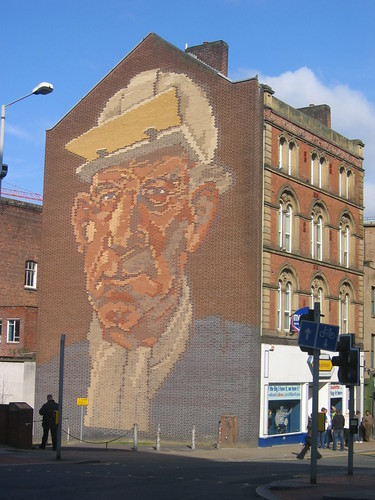Our new section of relief road is proving fairly popular with drivers, but it has created a real challenge for the RSPCA in Sheffield, who were forced to close their animal shelter when the road was built. Fund raising for a new centre is underway in the form of Monty's Appeal, but in the meantime facilities in Sheffield are restricted.
At present a small building close to the original site is being used for kennels. This was a spectacularly ugly building until last summer, when it received the Phlegm treatment.
I pass it twice a day but I can't really get more than a fleeting glimpse when I'm travelling past, so we decided to go and take a closer look at the weekend.
The artwork is great, but Mr TLC had to drag me away - the sound of all those dogs howling was heart rending, but that may have been partly because it was breakfast time.
Links- updated
Meet Phlegm - he introduces himself to the readers of fatcap, a graffiti blog
Phlegm's blog
Phlegm's official art site includes some great photos
--
Originally published here on my main blog http://three-legged-cat.blogspot.com/
Comments on the original post
Showing posts with label Architecture. Show all posts
Showing posts with label Architecture. Show all posts
Tuesday, 22 April 2008
Sunday, 13 April 2008
Culture Vultures
 After I wrote about the steelworker mural the other day, I suddenly remembered the vultures.
After I wrote about the steelworker mural the other day, I suddenly remembered the vultures.I used to love walking past the vultures. Part way down Arundel Gate in Sheffield was an end wall with a brick mural of four vultures. Like the steelworker, this was also commissioned by Sheffield City Council, but this one was built six years earlier than the steelworker, in 1980 and was designed by Ric Bingham, from the Landscape and Planning Department.
I used to play a kind of mental game every time I passed the vultures. As a child, I was given a copy of the soundtrack to Walt Disney's Jungle Book. One track on the record was the scene with the four vultures."What we gonna do?""I dunno, what d'you wanna do?" I loved it, I learned it off by heart, although I wasn't so keen on the song that formed the second part of the track - the start of that was a lift the stylus off the record moment.
 When I arrived in Sheffield and spotted this particular mural it immediately brought back childhood memories and had me playing the scene from the Jungle Book in my head. I don't know if Disney's vultures were any kind of inspiration for this mural, but I always associate the two.
When I arrived in Sheffield and spotted this particular mural it immediately brought back childhood memories and had me playing the scene from the Jungle Book in my head. I don't know if Disney's vultures were any kind of inspiration for this mural, but I always associate the two.So why hadn't I thought about or noticed my feathered friends lately? Were they still there, or had they fallen victim to the major redevelopments in that part of town? I went back to check them out. They are still there, but whereas once they were a focal point in a run down area, now they are slightly overpowered by the large new buildings around them. In fact, the four culture vultures sit just across the road from one of my newer friends the Millennium Galleries, surveying the relative newcomer that has temporarily grabbed my attention.
I'm probably not the only one who has been overlooking them, whilst I was snapping away taking some photos, other people stopped to look; but then, maybe that was just because I was re-enacting a certain movie scene for the benefit of Mr TLC. Unfortunately, Mr TLC had wandered off to sit on a bench just down the road, something I had completely failed to notice. I'd like to think that the people who stopped were looking at the mural, and not at the crazy woman having a conversation with herself in a fake Liverpool accent.
"Now don't start that again!"
--
Originally published here on my main blog http://three-legged-cat.blogspot.com/
Comments on the original post
Wednesday, 9 April 2008
A Man of Steel
I thought I'd show you one of Sheffield's best known faces. I can't tell you who he is, but I can tell you that this brick mural was based on the image of a real steelworker. Some adaptations to the man's appearance were made to allow the image to be created from coloured bricks.
"The eyes had to be enlarged, for example, or the pupils and the whites would have been smaller than a brick."
Paul Waplington
After an adjoining building was demolished, the City Council commissioned artist Paul Waplington to design the mural. The Council's Works Department then constructed it.
What are this image's vital statistics? Estimates seem to vary: everyone quotes the number of bricks used at 30000 and the number of types of mortar used is usually given as 5. The number of different types of bricks that were used is unclear - some sources say 12, others 18. I tried to count them for myself and came up with a different figure, so I won't add to the confusion! The differences in the colours of the various mortars seem to have become less noticeable over time, perhaps the same has happened to some of the bricks.
The mural was built in 1986, the year when I moved to Sheffield. There is another great shot of it here.
--
Originally published here on my main blog http://three-legged-cat.blogspot.com/
Comments on the original post
Monday, 24 March 2008
Pavilioned in Splendour
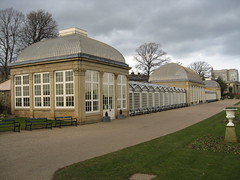 The Botanical Gardens, Sheffield contain a surprising number of listed structures, including some beautifully restored glass pavilions. It's not hard to see why these mini crystal palaces are so popular both with local people and with visitors to the city; they are not just elegant buildings, they are also home to several interesting collections of plants.
The Botanical Gardens, Sheffield contain a surprising number of listed structures, including some beautifully restored glass pavilions. It's not hard to see why these mini crystal palaces are so popular both with local people and with visitors to the city; they are not just elegant buildings, they are also home to several interesting collections of plants.Of course, the pavilions haven't always looked like this; when I first moved to Sheffield in the mid-eighties they were in a very sorry state. Only the three domed sections remained, the linking walkways had long since disappeared. The parts that were left were in very poor repair, there were plants growing in the masonry, holes in the roofs and many broken panes of glass, some roughly boarded up, others left open to the elements. I remember thinking that the buildings must have been beautiful in their heyday , but I never imagined that I would see them reborn and restored along with the rest of the gardens.
The state of the pavilions seemed to mirror Sheffield's fortunes. When they were first built for the opening of the Botanical Gardens in 1836, Sheffield was a prosperous place, sufficiently so for the purchase of the land and the creation and upkeep of the gardens to be paid for by the selling of shares and subscriptions to well-to-do residents. However both the gardens and the pavilions proved costly to maintain and so, like the fortunes of some of the city's inhabitants, they went through good and bad times.
The upkeep of the pavilions proved to be particularly demanding: the panes of glass were damaged by weather, a hailstorm in 1843 is recorded to have broken 5700 square yards (4800 square metres) of glass; the wooden structure of the linking walkways was difficult to keep in good repair, with the result that they rotted and were demolished in around 1899; the domes even suffered bomb damage during World War II.
By the time I first saw the pavilions in 1987, the gardens had been publicly owned for many years. Of course this was the era of rate capping and cutbacks in public services, it was also a time when Sheffield was suffering economically with many local industries, particularly steel and mining, in serious decline. The council was in an impossible situation: the loss of business tax revenue, cuts in grants from central government and rate capping left them with a serious shortfall in their finances. (I am not suggesting that the council made the best possible financial decisions, that's a separate debate entirely, merely that I believe that whatever they did, they couldn't have made ends meet at that time.) Unsurprisingly maintaining garden buildings was not at the top of the council's list of priorities, so the poor state of the glasshouses was in fact a direct result of the city's economic downturn.
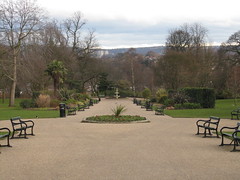 The opportunity for restoration arrived some years later when the Sheffield Botanical Gardens Trust made a successful bid for lottery funding. In 1997 the Heritage Lottery Fund awarded just over £5 million to the Trust for the complete restoration of the gardens, but 25% in matching funds had to be raised. It was a long and difficult project, but they managed it, the Botanical Gardens today are almost unrecognisable compared to my first visit.
The opportunity for restoration arrived some years later when the Sheffield Botanical Gardens Trust made a successful bid for lottery funding. In 1997 the Heritage Lottery Fund awarded just over £5 million to the Trust for the complete restoration of the gardens, but 25% in matching funds had to be raised. It was a long and difficult project, but they managed it, the Botanical Gardens today are almost unrecognisable compared to my first visit.The pavilions were once the largest glasshouses in the city (a title that is now held by the Winter Gardens in the city centre), and are often erroneously associated with Sir Joseph Paxton, in fact they are known locally as the "Paxton Pavilions". The ridge and furrow style of the linking walkways is typical of Paxton, particularly of his glasshouse at Chatsworth. Paxton was one of the judges for the competition to design the gardens, but the belief that the pavilions were designed by him is nothing more than a local legend, they were in fact designed by a local architect, Benjamin Broomhead Taylor.
Some necessary changes have been made to the original designs during restoration. The rebuilt linking walkways are similar in appearance to the originals, but have been fabricated, rather appropriately, from stainless steel rather than wood; so hopefully they will last rather longer than the originals. However only the linking sections have been rebuilt, one old photo shows additional ridge and furrow glasshouses attached to each end of the building, but these appear to have been short lived - there are many other images where they are missing, as they are now. Modern environmental controls and a system for collecting and storing rainwater for use in irrigation have been incorporated into the design.
The pavilions now contain collections of plants from the Himalayas, the Meditaerrranean, Australasia and South America; all plants that would not survive outside in Sheffield, but which thrive under glass. The glasshouses maintain their historic appearance whilst being functional buildings that will be used for many years to come. They are certainly pavilioned in splendour, and frequently girded in praise.
Links
Sheffield Botanical Gardens official website
Sheffield City Council official website
Some 360 degree tours of the gardens, including views inside and outside the pavillions
Wikipedia entry
There is also a Flickr group for the Botanical Gardens here
Further reading
Sheffield Botanical Gardens People Plants and Pavilions by R. Alison Hunter, published by the Friends of the Botanical Gardens, 2007. Available from the Botanical Gardens shop, local bookshops and tourist information offices, current price £4.95.
--
Originally published here on my main blog http://three-legged-cat.blogspot.com/
Comments on the original post
Labels:
Architecture,
Botanical Gardens,
Ecclesall,
Parks and Gardens
Sunday, 24 February 2008
The Pit of dis Bear
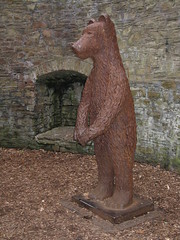 We took a stroll around Sheffield's Botanical Gardens yesterday, making the most of a swift return to unseasonably warm weather. Tucked away in the gardens is one of Sheffield's historical curiosities: a bear pit.
We took a stroll around Sheffield's Botanical Gardens yesterday, making the most of a swift return to unseasonably warm weather. Tucked away in the gardens is one of Sheffield's historical curiosities: a bear pit.This Grade II listed structure dates from 1836 and housed two bears until the 1870s. According to an information board at the site, there is a local legend that the removal of the bears occurred after a child fell into the pit and was killed; however the official website recounts this story as historical fact: you will have to make up your own mind as to whether to believe the tale.
There are two small dens on either side of the main entrance to the pit which originally housed the bears. The first thing that struck me about these was that they are incredibly small: I can imagine that a large bear would become very irritable very quickly in such a small space, but sadly I suspect that was probably the intention. There are large metal grilles at the entrance that can be pulled across and locked to keep the occupants inside; these were re-instated during the restoration of the pit.
 The pit itself is around 8 or 9 metres across (large enough to be seen on Google Earth - see below), and is topped off with elegant new railings that helpfully prevent you from falling in and being eaten by bears...
The pit itself is around 8 or 9 metres across (large enough to be seen on Google Earth - see below), and is topped off with elegant new railings that helpfully prevent you from falling in and being eaten by bears...The beautifully restored modern day version of the bear pit also contains a rather splendid bear. David Mayne's 2005 "Bear" sculpture looks fantastic in this perfect setting. It is life sized, standing at around 2m high. The bear looks pretty friendly standing on his back paws with his front legs dangling down at his sides (and of course with just one bear, no fights can break out). The sculpture is made from mild steel with a rusted finish that is perfect for a brown bear's pelt.
Children (and adults) can find a clue from the riddle trail written around the base of the sculpture. The riddle is one of a series, written by well known local author Berlie Doherty, to encourage people to explore the gardens.
I'll certainly be exploring further in the not too distant future.
View Larger Map
N.B. The aerial images on Google were taken during the period when the Botanical Gardens were undergoing major restoration work.
--Originally published here on my main blog http://three-legged-cat.blogspot.com/
Comments on the original post
Labels:
Architecture,
Botanical Gardens,
Ecclesall,
Parks and Gardens
Thursday, 24 January 2008
A Bridge of Size
 The design for Sheffield's next great landmark was unveiled today.
The design for Sheffield's next great landmark was unveiled today.Danish architect Tim Norlund, has produced the winning design for a highly unusual footbridge, which was described as "inspired and inspiring" by the judges. However at around £2 million, it is going to be pretty pricey and I'm sure this price tag will cause more than a little controversy.
The new bridge is going to be located on the Sheffield Parkway, currently a rather dull and featureless dual carriageway that links Sheffield to the M1 and consequently provides most visitors with their first glimpse of my home city.
I think it's going to be stunning.
Updates:
To see the other designs shortlisted, visit the Darnall Forum
There is a discussion thread here on historicsheffield.co.uk
--
Originally published here on my main blog http://three-legged-cat.blogspot.com/
Comments on the original post
Labels:
Architecture,
Bridge,
Footpath,
Handsworth,
Parkway
Subscribe to:
Posts (Atom)
